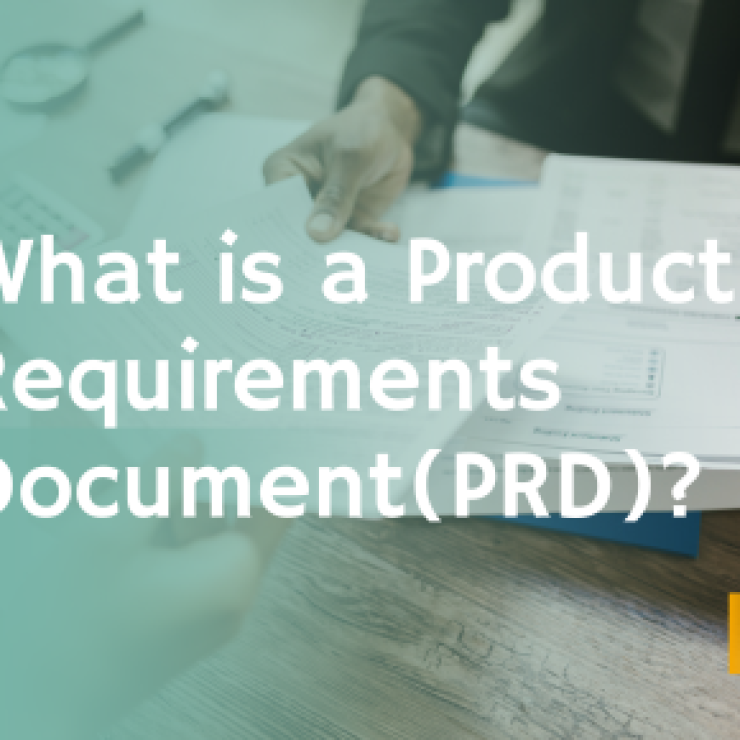A comprehensive project roadmap is vital to a SaaS company’s product development strategy. Essentially, a product roadmap serves as a bird’s-eye view of the team’s objectives, milestones, and goals over a specified period, promoting alignment and collaboration towards a shared vision.
To achieve this, it’s crucial to employ a reliable and user-friendly product roadmap tool. Given the plethora of options available in the market, selecting the most appropriate one for your organization can be daunting. In this blog, we present a unique take by exploring 9 of the best product roadmap tools for SaaS in 2023, featuring the likes of Saasfe.
What is a product roadmap tool?
A product roadmap tool is a software application designed to assist product development teams in creating, managing, and sharing product roadmaps. These tools visually represent the product development plan and help stakeholders understand the team’s progress towards meeting their objectives.
Typically, a product roadmap tool will offer various features to support product development, such as drag-and-drop functionality, customizable templates, and collaboration tools. These features enable teams to create detailed product roadmaps that can be shared with stakeholders clearly and concisely.
One of the primary benefits of using a product roadmap tool is that it promotes alignment within the product development team. By providing a clear view of the team’s objectives and progress towards meeting them, all team members can work together towards the same end goal.
Product roadmap tools can also help identify potential roadblocks and risks to the product development plan. This enables teams to proactively address these issues, reducing the likelihood of delays or failures in the product development process.
How to create a roadmap?
Creating a roadmap is a crucial step in any product development process, as it provides a visual representation of the team’s objectives, milestones, and goals. Here are the steps to create a roadmap:
1. Identify your goals: Determine the key objectives of your product development plan and prioritize them based on importance and feasibility.
2. Define your milestones: Break down your objectives into smaller milestones that are easier to measure and track. This helps to create a clear timeline for achieving your goals.
3. Determine your resources: Identify the resources, including a budget, team members, and technology, that are necessary to achieve your objectives.
4. Create your roadmap: Use a product roadmap tool to create a visual representation of your plan. Make sure to include all relevant information, such as timelines, milestones, and resource allocation.
5. Review and adjust: Once you have created your roadmap, it’s essential to review it regularly to ensure you’re on track to achieving your goals. If necessary, adjust your plan to address any unforeseen obstacles or changes in your objectives.
When creating a roadmap, it’s essential to involve all relevant stakeholders, including team members, management, and external partners. This promotes alignment and ensures that everyone is working towards the same objectives. Additionally, it’s crucial to be transparent about your roadmap and share it with all stakeholders to promote collaboration and accountability.
What is a roadmap methodology?
A roadmap methodology is a structured approach to creating and managing a product roadmap. A product roadmap is a high-level visual representation of the product development plan that outlines the goals, objectives, and milestones of the product development process over a specific period. A roadmap methodology aims to ensure that the product development plan is aligned with the overall business strategy and that all stakeholders are working towards the same goals.
A roadmap methodology typically involves several key steps, including:
1. Defining the vision and goals: The first step in a roadmap methodology is to define the vision and goals for the product development plan. This involves understanding customer needs, market trends, and business objectives.
2. Prioritizing features and initiatives: The next step is prioritizing the features and initiatives to help achieve the vision and goals. This involves considering factors such as customer demand, business value, and technical feasibility.
3. Creating a roadmap: Once the features and initiatives have been prioritized, the next step is to create a roadmap that outlines the timeline for delivery. The roadmap should be flexible and adaptable to changes in customer needs and market trends.
4. Communicating the roadmap: The final step in a roadmap methodology is to communicate the roadmap to stakeholders. This includes team members, management, and external partners. Communication should be ongoing to ensure that everyone is aware of the progress and any changes to the product development plan.
How do I choose a roadmap tool?
Choosing a roadmap tool can be overwhelming, but there are several factors you can consider to make an informed decision. Here are some factors to consider when choosing a roadmap tool:
1. Ease of use: Look for a roadmap tool that is easy to use and navigate. The tool should not require extensive training or technical expertise to use.
2. Collaboration features: Look for a roadmap tool that enables collaboration and communication among team members and stakeholders. The tool should allow team members to easily share ideas, feedback, and updates.
3. Customization capabilities: Look for a roadmap tool that allows you to customize your roadmap according to your specific needs and requirements.
4. Integration capabilities: Look for a roadmap tool that integrates with other project management tools such as Jira, Asana, or Trello.
What are the benefits of using a product roadmap tool?
There are several benefits of using a product roadmap tool for product development teams, including:
1. Clear visualization: A product roadmap tool provides a clear visual representation of the product development plan, making it easier to understand and communicate. It helps stakeholders to visualize the product development process, making it easier to provide feedback and align the team towards a common goal.
2. Alignment: A product roadmap tool promotes alignment within the team by providing a clear view of the product development plan. All team members can work towards the same goals and objectives, reducing the likelihood of miscommunication or confusion.
3. Resource allocation: A product roadmap tool helps teams allocate resources effectively, ensuring they have the necessary resources to achieve their objectives. This can include budget, team members, and technology.
4. Risk management: A product roadmap tool helps teams to identify potential roadblocks and risks to the product development plan. This enables teams to proactively address these issues, reducing the likelihood of delays or failures in the product development process.
5. Collaboration: A product roadmap tool promotes collaboration among team members and stakeholders by providing a platform for sharing information and feedback. This enables everyone to have a voice in the product development process, leading to better outcomes.
Who should have access to your product roadmap tool?
Determining who should have access to a product roadmap tool largely depends on the size and complexity of the product development team and the organization’s culture and structure. However, generally speaking, the following stakeholders should have access to a product roadmap tool:
1. Product development team members: All team members involved in the product development process should have access to the product roadmap tool. This includes developers, designers, project managers, and other relevant team members.
2. Management: Management should have access to the product roadmap tool to ensure that the product development plan aligns with the overall business strategy.
3. Executives: Executives should have access to the product roadmap tool to understand the product development plan and provide support and resources to the team.
4. External partners: External partners, such as vendors or consultants, who are involved in the product development process should have access to the product roadmap tool to ensure alignment and collaboration.
It’s important to note that access to the product roadmap tool should be granted on a need-to-know basis. Too many stakeholders with access to the tool can lead to confusion and miscommunication. Conversely, not enough stakeholders with access to the tool can hinder collaboration and alignment. Therefore, it’s important to strike a balance and ensure that the right stakeholders have access to the tool at the right time.
Free Product Roadmap Tools For SaaS Companies
1. SAASFE
SAASFE stands out as one of the best free roadmap tools available for collecting customer feedback and feature ideas, and creating a product roadmap. With SAASFE, you can accelerate your brand’s growth by allowing customers to vote for your business idea, while also highlighting key updates and sharing announcements in a user-friendly manner.
This tool offers a simple and easy-to-use platform for submitting feedback, without the chaos and complexity of other feedback submission processes. The interface is designed with a great user experience, making it a standout option among other feedback platforms.

Pros:
- Dedicated product roadmap tool
- Customizable interface
- Good collaboration features
Cons:
- Limited integrations with other tools as of now
2. Trello
Trello is a popular project management tool that can also be used for creating product roadmaps. It offers a simple visual interface that allows teams to collaborate easily and track progress. Trello’s drag-and-drop functionality is intuitive, and its free version includes unlimited boards, cards, and lists.

Pros:
- Easy-to-use interface
- Great collaboration features
- The free version offers unlimited boards and cards
Cons:
- Limited customization options
- Limited reporting capabilities
- Not specifically designed for product road mapping
3. Asana
Asana is another popular project management tool that can be used for product road mapping. Its user-friendly interface allows teams to easily create and manage tasks, projects, and timelines. Asana’s free version includes basic features like task management, calendar view, and reporting.
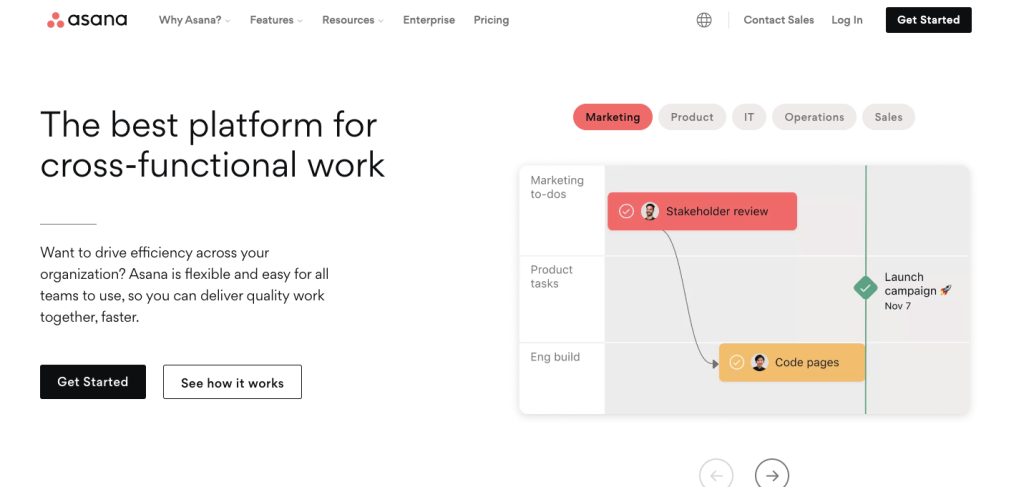
Pros:
- Intuitive interface
- Good task management features
- Basic reporting capabilities
Cons:
- Limited customization options
- Limited integrations with other tools
- Not specifically designed for product road mapping
4. Wrike
Wrike is a project management tool offering various features, including product roadmap creation. Its drag-and-drop interface makes creating and managing projects easy, and its free version includes basic features like task management, real-time activity stream, and Gantt charts.
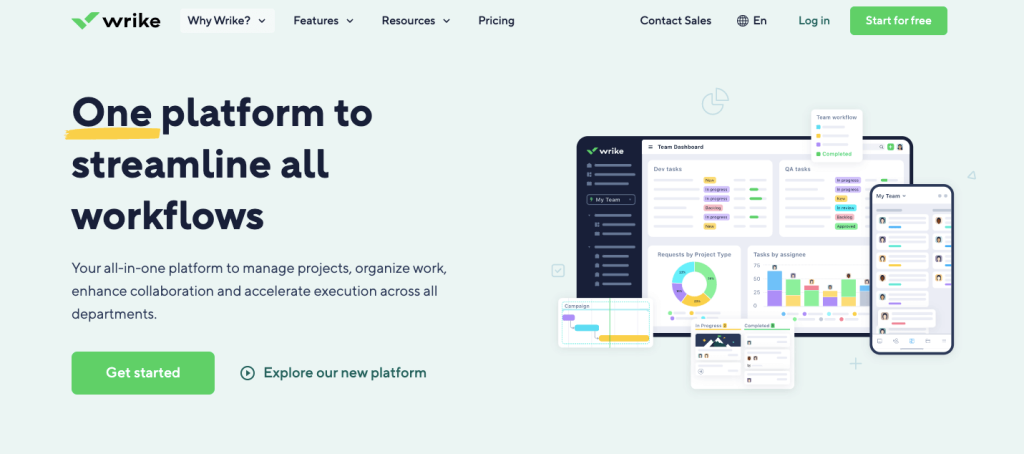
Pros:
- Intuitive interface
- Good task management features
- Real-time activity stream
Cons:
- Limited customization options
- Limited reporting capabilities
- Not specifically designed for product road mapping
5. ProductPlan
ProductPlan is a dedicated product roadmap tool offering various features to help teams create and manage product roadmaps. Its easy-to-use interface allows teams to create, share, and track real-time product plans. ProductPlan’s free version includes basic features like roadmap creation, user permissions, and team collaboration.
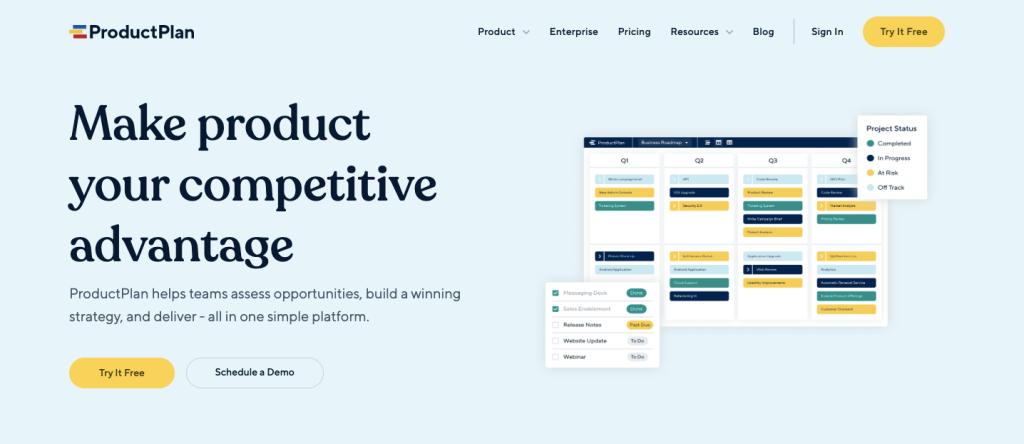
Pros:
- Dedicated product roadmap tool
- Easy-to-use interface
- Good collaboration features
Cons:
- Limited customization options
- Limited integrations with other tools
- Free version limited to one roadmap
6. Roadmunk
Roadmunk is another dedicated product roadmap tool offering various features to help teams create and manage product roadmaps. Its drag-and-drop interface makes creating and managing product plans easy, and its free version includes basic features like roadmap creation, user permissions, and team collaboration.

Pros:
- Dedicated product roadmap tool
- Easy-to-use interface
- Good collaboration features
Cons:
- Limited customization options
- Limited integrations with other tools
- Free version limited to one roadmap
7. Aha!
Aha! is a product roadmap tool offering various features to help teams create and manage product roadmaps. Its drag-and-drop interface makes creating and managing product plans easy, and its free version includes basic features like roadmap creation, user permissions, and team collaboration.

Pros:
- Dedicated product roadmap tool
- Robust feature set
- Good collaboration features
Cons:
- Limited customization options
- Limited integrations with other tools
- Free version limited to one product
8. ClickUp
ClickUp is a project management tool that can also be used for creating product roadmaps. Its user-friendly interface allows teams to easily manage tasks, projects, and timelines. ClickUp’s free version includes basic features like task management, calendars, and team collaboration.
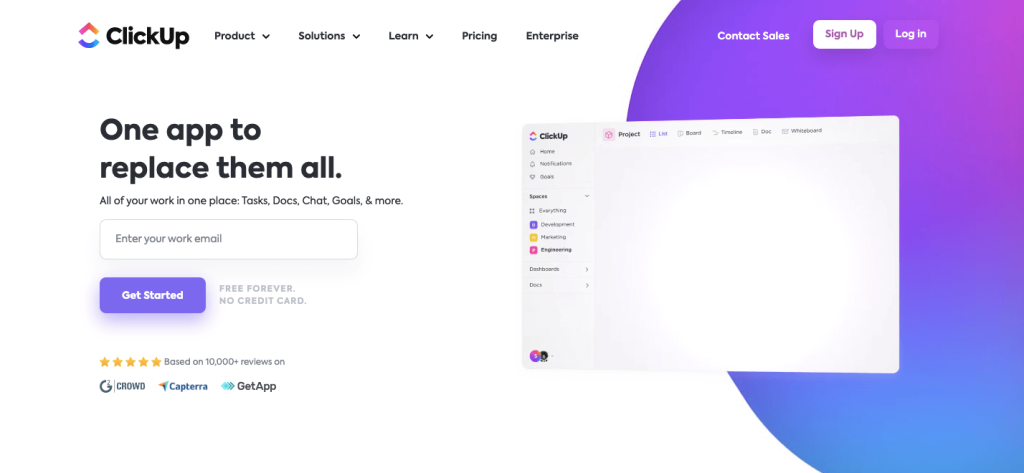
Pros:
- Intuitive interface
- Good task management features
- Good collaboration features
Cons:
- Limited customization options
- Limited reporting capabilities
- Not specifically designed for product road mapping
9. Smartsheet
Smartsheet is a collaborative work management tool that can be used for product road mapping. Its user-friendly interface allows teams to easily manage projects, tasks, and timelines. Smartsheet’s free version includes basic features like task management, collaboration, and Gantt charts.
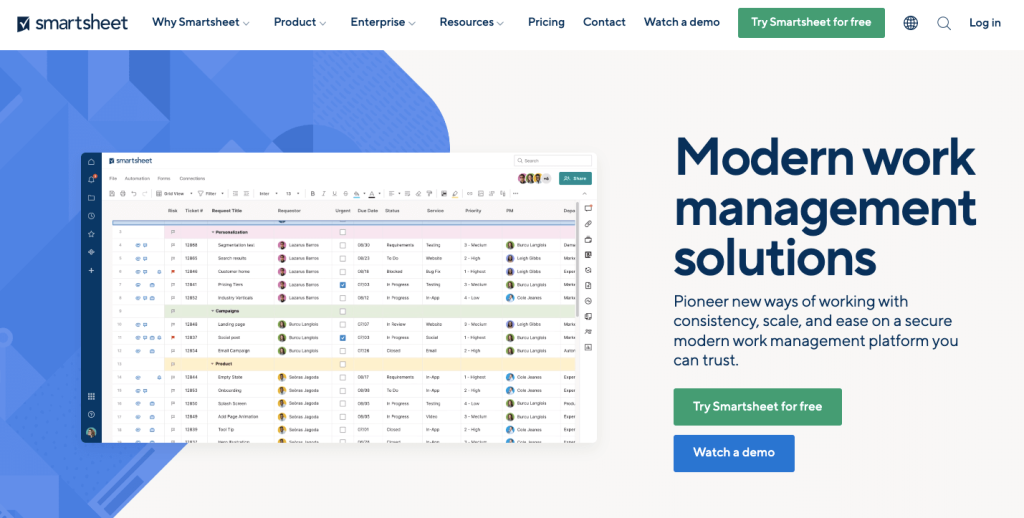
Pros:
- Intuitive interface
- Good task management features
- Good collaboration features
Cons:
- Limited customization options
- Limited reporting capabilities
- Not specifically designed for product road mapping
In conclusion, many free product roadmap tools are available in the market, each with its own strengths and weaknesses. When choosing a tool, it’s important to consider your team’s needs, the features you require, and the level of customization you require. Whether you’re looking for a dedicated product roadmap tool or a more general project management tool, a free option is available to suit your needs.
A public roadmap is typically a public webpage where an organisation shares what they are working on and what they have recently released, accessible to anyone. Most SaaS companies’ roadmaps tend to be timeline-driven or indicate broad time horizons for key features.
Roadmaps are critically important documents that set out a product team’s overall strategic plan. That means building a view of what is going to be delivered, why it’s valuable, and roughly when it’ll be available.
By allowing your users to vote and comment on your product roadmap, you are giving yourself another channel of communication with them. This can only help to focus your product development efforts and give you confidence that you are working on the right user stories.


